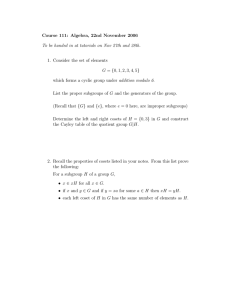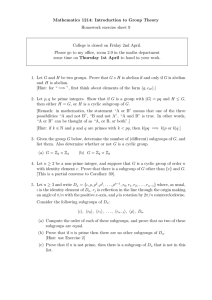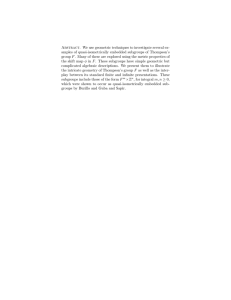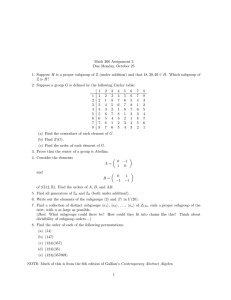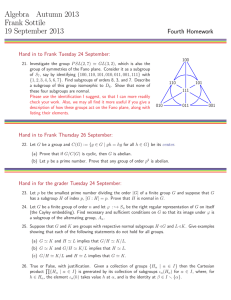Finding Subgroups
advertisement
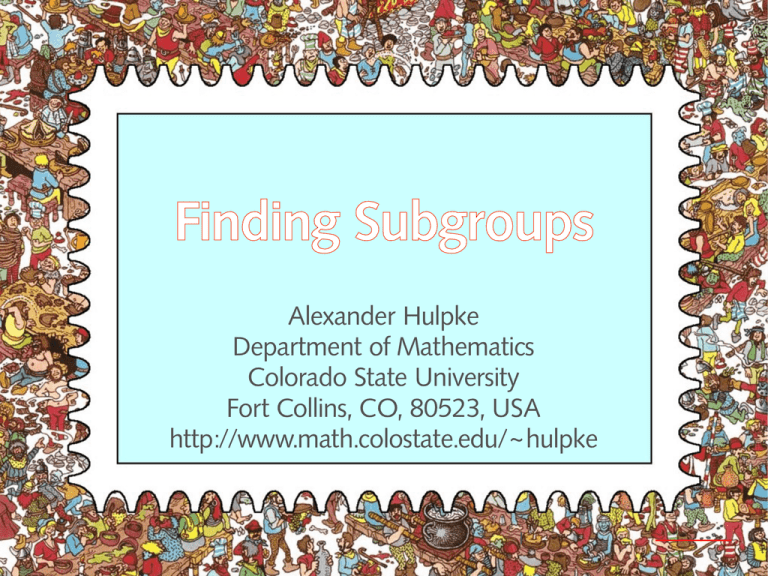
Finding Subgroups
Alexander Hulpke
Department of Mathematics
Colorado State University
Fort Collins, CO, 80523, USA
http://www.math.colostate.edu/~hulpke
I
A Popular Problem
Given a finite (permutation, matrix) group G,
find subgroups: Frequent task (CANNON, 2011)
-Not all, but specific properties, one or all.
-1Ug.
Up
to
conjugacy
U
~
g
There is no universal algorithm (how to
specify desired properties). Best strategies:
- Search in smaller groups (sub- or factor-)
- Use hooks in existing algorithms (or put in
own hooks). Thus survey what exists.
Admission of Failure
How to organize this?
One obviously would like an
organization by task.
I only can give a classification by
algorithm (showing you a nice wrench
set instead of repairing your car).
Still, I hope this might help to give an
idea where to put limitation hooks (and
what kinds of hooks are suitable).
Possible Strategies
Build Up
Just Find It
Between
Build Down
Direct Constructions
Direct methods for the
construction of
particular subgroups
without the need to
build part of the
subgroup lattice.
• Cyclic Subgroups
• Stabilizers
• Sylow Subgroups
• PCore
• Composition Series,
Radical
Cyclic Subgroups
There are algorithms that
compute conjugacy class
representatives of elements.
Eliminate coprime powers gx,
gcd(|g|,x)=1, to get cyclic
subgroups up to conjugacy.
• Cyclic Subgroups
• Stabilizers
• Sylow Subgroups
• PCore
• Composition
Series, Radical
Cyclic Subgroups
CANNON
,
Cyclic
Subgroups
• ,
NEUBÜSER
There are algorithms that
compute conjugacy class
representatives of elements.
SOUVIGNIER
MECKY,
1997
Stabilizers
•
1989
• Sylow Subgroups
• PCore
,
H.
Eliminate coprime powers gx, CANNON
HOLT•, Composition
2000,
gcd(|g|,x)=1, to get cyclic
Radical
2006 Series, 2013
subgroups up to conjugacy.
Orbit / Stabilizer
If G acts on Ω, the Orbit/
Stabilizer algorithm finds the
orbit of ω∈Ω by repeated
computation of images under
generators.
Schreier generators for StabG(ω).
Problems:
• Cyclic Subgroups
• Stabilizers
• Sylow Subgroups
• PCore
• Composition
Series, Radical
• Cost (time and memory) is proportional to
stabilizer index.
• Not every subgroup is a natural stabilizer.
Backtrack
Backtrack search algorithms for
particular actions of perm. groups:
• (Point, Tuple), Set stabilizer
• Element Centralizer
• Subgroup Normalizer
• Intersection
• Cyclic Subgroups
• Stabilizers
• Sylow Subgroups
• PCore
• Composition
Series, Radical
Problems:
• Inherently exponential time, hard to analyze.
• Very hard to extend.
Sylow Structure
Sylow subgroups have a
nontrivial centre.
They thus lie in the centralizer
of an element of order p.
Compute these centralizers
and then search in the centre
factor.
PCore as intersection of
conjugates.
• Cyclic Subgroups
• Stabilizers
• Sylow Subgroups
• PCore
• Composition
Series, Radical
Composition Structure
Composition series by finding
kernels of nontrivial
homomorphisms. (Transitive,
Imprimitive actions; them
analysis of primitive case.)
(Solvable) Radical is the kernel
of the action of G on
nonabelian composition
factors.
• Cyclic Subgroups
• Stabilizers
• Sylow Subgroups
• PCore
• Composition
Series, Radical
Build Up
It seems plausible to
try to build up
subgroups from
smaller ones, starting
with cyclic subgroups.
• Find Generators
• Cyclic Extension
Indeed this is possible. A main difficulty is that
it will generate lots of irrelevant and
redundant groups and conjugacy tests for
subgroups are expensive.
Find Generators
Any U<G is generated by a set of
elements u1,...,uk. Each ui lies in conj. class.
Thus classify such tuples (with particular
properties, e.g. presentation) up to
conjugacy (CG(u) orbits on xG are given
by double cosets CG(x)\G/CG(u).
GAP-Function: IsomorphicSubgroups,
TomDataSubgroupsAlmostSimple
Hook: Internal function MorClassLoop
Cyclic Extension
More systematically, construct U as
U=〈V,x〉with smaller V, x ∈NG(V).
Seed with perfect subgroups. Find via
generator images from catalog.
GAP-Function: LatticeByCyclicExtension
Hook: Function to discard V, flag to skip
nontrivial perfect subgroups.
Problems: Many, expensive conjugacy
tests. Store by list of cyclic subgroups.
Cyclic Extension
More systematically, construct U as
U=〈V,x〉with smaller V, x ∈NG(V).
Seed with perfect subgroups. Find via
generator images from catalog.
GAP-Function: LatticeByCyclicExtension
Hook: Function to discard V, flag NtoEUBÜSER
skip
nontrivial perfect subgroups.
1960
Problems: Many, expensive conjugacy
tests. Store by list of cyclic subgroups.
Cyclic Extension
More systematically, construct U as
U=〈V,x〉with smaller V, x ∈NG(V).
Seed with perfect subgroups. Find via
generator images from catalog.
GAP-Function: LatticeByCyclicExtension
Hook: Function to discard V, flag to skip
nontrivial perfect subgroups.
Problems: Many, expensive conjugacy
tests. Store by list of cyclic subgroups.
Complements
For N⊲G, a complement is a
subgroup C≤G such that
N⋂C=〈1〉and NC=G.
G
C C2 C3
N
〈1〉
Complements fall in classes under N. In
general there can be multiple (or no)
classes. Sufficient to find representatives.
As C≅G/N, consider as homomorphisms
G→G with kernel N. Every g ∈G is
mapped to g ·ng with the cofactor ng ∈ N.
Find these ng for generators of G/N.
Technical DETAILS
Linear Algebra for Cocycles
If N is elementary abelian then one can collect
these equations into a G/N-part and an N-part.
E.g. a relator Na·Nb·Na for G/N becomes
a·na ·b·nb·a·na = a·b·nab·nb·a·na = a·b ·a·naba·nba·na
Thus in G, (a·b ·a)−1∈N equals the (linearly
written!) vector space element na·(Mba+1)+
nb·Ma where Mx is the action induced by x on
N. For given Mx, the ny are variables.
These equations for all relators yield a linear
inhomogeneous system of equations, solutions
are cocycles Z1. Conjugacy by N gives B1.
Technical DETAILS
Linear Algebra for Cocycles
If N is elementary abelian then one can collect
these equations into a G/N-part and an N-part.
E.g. a relator Na·Nb·Na for G/N becomes
a·na ·b·nb·a·na = a·b·nab·nb·a·na = a·b ·a·naba·nba·na
Thus in G, (a·b ·a)−1∈N equals the (linearly
written!) vector space element na·(Mba+1)+
ELLER,
nb·Ma where Mx is the action induced by x Con
N
EUBÜSER,
N. For given Mx, the ny are variables.
WRIGHT
linear1990
These equations for all relators yield a
inhomogeneous system of equations, solutions
are cocycles Z1. Conjugacy by N gives B1.
Technical DETAILS
Solvable Normal Subgroup
If N is solvable, take a G-normal
As G/N=C, elements
series for N with elementary
of G induce no outer
abelian factors.
automorphisms of Ci
In each step take M⊲G elementary
abelian with N ≥ M. Assume we
G
found representatives Ci for the
complements to N/M in G/M.
C
C
C
N
Then for each Ci find
representatives for the
complements to M in Ci and fuse
these under action of XXXX
NG(Ci). CG(Ci)
1
M
...
i
k
...
1
Technical DETAILS
Solvable factor
If G/N is solvable, there is A⊲G such that
A/N⊲G/N is a normal p-subgroup.
Any complement C in G contains
G
a complement D≤C in A where
D is a p-subgroup.
B=N (D)
A
Up to conjugacy D≤S,
S
where S≤A is a fixed
N
p-Sylow subgroup.
D
S∩N
G
As A⊲G we have that D⊲C,
and thus C≤NG(D)=:B.
〈1〉
C
In Between
For a given U<G the
subgroups U<V<G
correspond to block
systems for the action
of G on cosets of U.
Finding blocks is easy: Take a potential block
seed containing two points (orbit of point
stabilizer). Form Images, combine to partition
(fusing cells if neccessary).
In Between
For a given U<G the
subgroups U<V<G
correspond to block
systems for the action
of G on cosets of U.
• Subgroups Between
• Maximal Subgroups
• Maximality Test
(Future thesis
topic ... )
Finding blocks is easy: Take a potential block
seed containing two points (orbit of point
stabilizer). Form Images, combine to partition
(fusing cells if neccessary).
Subgroups Between
Take the permutation action on
subgroups and construct all block
systems systematically.
This yields all subgroups between two.
GAP-Function: IntermediateSubgroups,
AscendingChain.
Caveat: Needs to write down
permutations for action on cosets.
Inefficient if there are many blocks.
Primitive Groups
If a permutation group G affords no
nontrivial block systems, it is primitive.
The O’NAN-SCOTT Theorem states that
then Soc(G)=Tn, T simple and either
n and G≤AGLn(q). StabG(1)
Soc(G)=p
•
complements Soc(G)=pn . Or
• Soc(G)=Tn nonabelian, G≤Aut(T)≀Sn.
StabG(1)⊳StabSoc(1) which combines
diagonal/direct product of maximals.
Primitive Groups
If a permutation group G affords no
nontrivial block systems, it is primitive.
The O’NAN-SCOTT Theorem states that
then Soc(G)=Tn, T simple and either
n and G≤AGLn(q). StabG(1)
Soc(G)=p
•
complements Soc(G)=pn . Or
• Soc(G)=Tn nonabelian, G≤Aut(T)≀Sn.
Using Cohomology
StabG(1)⊳StabSoc(1) which combines
diagonal/direct product of maximals.
Primitive Groups
If a permutation group G affords no
{
(t,t,...,t
)|
t
∈T}
nontrivial block systems,
it isn)|primitive.
{(m1,m2,...,m
mi∈M }
M maximal
in T.that
states
The O’NAN-SCOTT Theorem
then Soc(G)=Tn, T simple and either
n
Soc(G)=p
andk,mG≤AGL
}, n=kl
n(q).
G(1)
•{(m1,m1,...,m1,...,m
k,...,mk)| m
i∈M Stab
complements Soc(G)=pn . Or
• Soc(G)=Tn nonabelian, G≤Aut(T)≀Sn.
StabG(1)⊳StabSoc(1) which combines
diagonal/direct product of maximals.
Find Maximal Subgroups
The possible socles arise from chief
factors M/N of G.
Homomorphism φ:G→action on M/N.
In the Image φ construct maximal
subgroups as normalizers of these
diagonals and direct products.
Base case: M/N simple, maxes of simple.
For the abelian case need complements
to abelian chief factors.
Find Maximal Subgroups
The possible socles arise from chief
factors M/N of G.
Homomorphism φ:G→action on M/N.
In the Image φ construct maximal
subgroups as normalizers of these
diagonals and direct products.
Base case: M/N simple, maxes
of ,simple.
CANNON
EICK,
For the abelian case need
to abelian chief factors.
HOLT
H.
complements
2004
2001
Find Maximal Subgroups
The possible socles arise from chief
factors M/N of G.
Homomorphism φ:G→action on M/N.
In the Image φ construct maximal
K
LEIDMANN, LIEBECK;
subgroups as normalizers of these
BRAY, HOLT, RONEY-DOUGAL
diagonals and direct products.
Base case: M/N simple, maxes of simple.
For the abelian case need complements
to abelian chief factors.
All maximal subgroups
Remaining (awkward) case: Twisted
wreath (Stabilizer in Soc(G) trivial).
Difficult complement, only for n>5.
Table Lookup/Generator Search for
maximals of simple.
Similar ideas for maximality test/
intermediate subgroups.
GAP-Function: (nonsolvable new, not all)
MaximalSubgroupClassReps
Hook: Options for O’NAN-SCOTT classes.
Downwards
Today’s standard tool is the (SolvableRadical) Trivial-Fitting model:
G
- R=Rad(G) is the largest solvable normal
S*
subgroup. (G/Rad is Trivial-Fitting)
*/Rad=Socle(G/Rad) is direct product
S
of simple nonabelian.
* acts on this socle as outer
G/S
automorphisms and thus is small (often
solvable).
Rad
⟨1⟩
Lifting Subgroups
Construct subgroups inductively in
steps over the elementary abelian
layers of the radical:
M,N⊲G, N/M elementary abelian.
Assume subgroups of G/N,
determine those of G/M.
G
Rad
N
M
Induction start with G/Rad.
⟨1⟩
Lifting Subgroups
Construct subgroups inductively in
steps over the elementary abelian
layers of the radical:
M,N⊲G, N/M elementary abelian.
CANNON,
Assume subgroups ofCOX
G/N,
,
H
OLT
determine those of G/M.
2001
H.
1999
2013
G
Rad
N
M
Induction start with G/Rad.
⟨1⟩
Inductive Step
WLOG (description in factor group, work
with pre-images and representatives) N⊲G
elementary abelian.
If U≤G, then U/U⋂N is complement
to N/U⋂N in UN/U⋂N.
As N is solvable this can be done
using cohomology.
Further fusion under the normalizer
of NU - action on cohomology.
G
NU
N
U
U∩N
〈1〉
Solvable/ Nonsolvable Case
If G is solvable this is all what is needed.
GAP-Function: SubgroupsSolvableGroup
Hook: Functions to limit cases in which
complements are searched for.
In the general case one needs initially
subgroups of G/Rad.
GAP-Function: LatticeViaRadical
Hook: Only subgroups within Rad<H⊲G.
(No filter function, as hard to specify.)
Radical Factor
For the initial step, G/Rad, use the
structure with large normal
subgroup:
is direct product of
simples. Combine subgroups
from simple factors.
S*/Rad
Any other subgroup U then
intersects S* in one of its
subgroups, again complement.
G
SU
U
S*
S∩U
Rad
〈1〉
Subgroups of Direct Product
S*/Rad=Socle(G/Rad)= ⨉Ti is a direct
product of simple nonabelian groups.
*/Rad projects on
Any
subgroup
U≤S
each component Ti as a subgroup Vi≤Ti .
- Conjugate Vi belong to conjugate U .
- For each factor Ti find list of subgroup
classes with cyclic extension/tables.
- Possible combinations are Subdirect
Products.
Subgroups of Direct Product
S*/Rad=Socle(G/Rad)= ⨉Ti is a direct
product of simple nonabelian groups.
*/Rad projects on
Any
subgroup
U≤S
each component Ti as a subgroup Vi≤Ti .
- Conjugate Vi belong to conjugate U .
- For each factor Ti find list of subgroup
classes with cyclic extension/tables.
- Possible combinations are
Products.
HOLT
2010
Subdirect
H.
1996,
2005
Technical DETAILS
Subdirect Products
U
Single product. Let U≤G⨉H with A≤G,
B≤H chosen and direct factor
projections α:U↠A, β:U↠B. Then:
D=(ker β)α⊲A and
α
β
U
A
B
A/D
β
E=(ker α) ⊲B.
E
Factor groups A/D 〈1〉 D
and B/E isomorphic.
ker β
ker α
〈1〉
〈1〉
Possible D,E and
〈1〉
isomorphisms A/D→B/E
parameterize U.
B/E
〈1〉
Where to go from here
How to use this
• Try to reduce the search to a subgroup
(or automorphism group of the
subgroup)?
• Determine how the subgroups you are
searching for behave in relation to
normal subgroups: Intersection, Span,
Complements.
Inclusion Information
The only generic lattice structure
algorithm I know determines inclusion
information by testing inclusion of all
conjugates in each subgroup.
Can one do better?
g iff VgU=Vg
Fixed
Cosets:
U<V
-
- Maximal subgroups of subgroups
- As part of construction?
